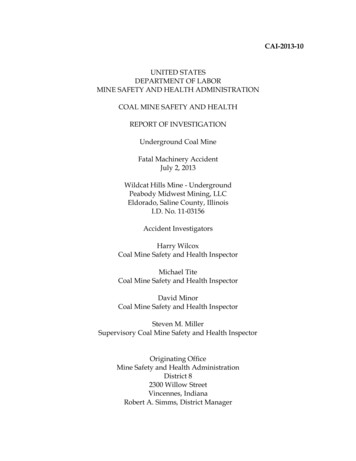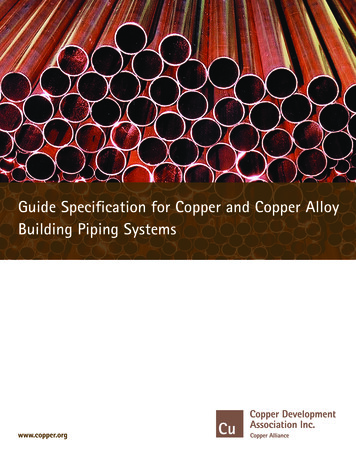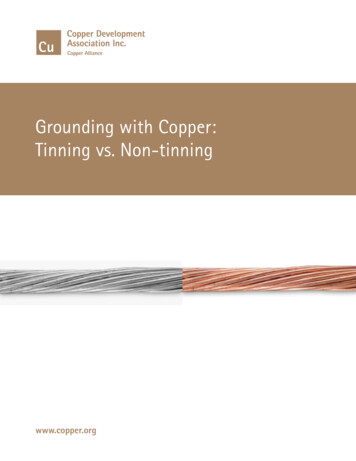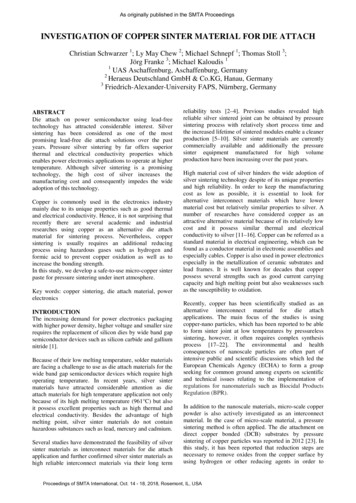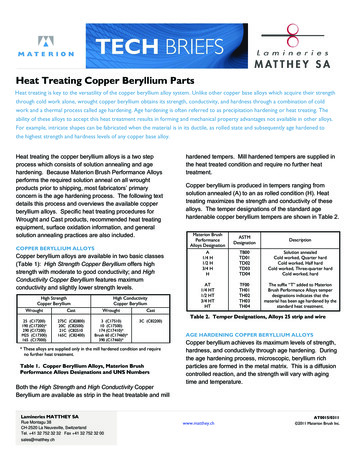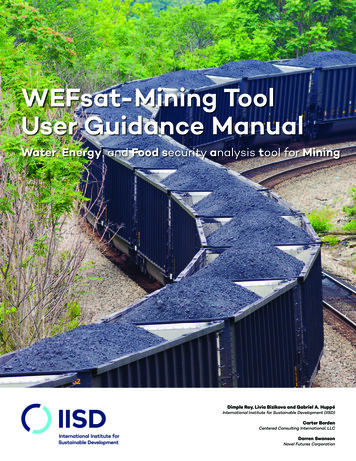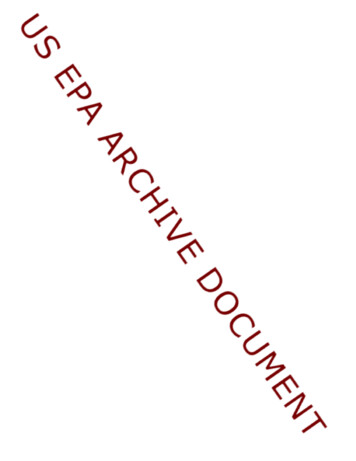
Transcription
Site Visit Report: Copper Range Company, White Pine MineMINE SITE VISIT:COPPER RANGE COMPANYWHITE PINE MINEU.S. Environmental Protection AgencyOffice of Solid Waste401 M Street SWWashington, DC 20460
Site Visit Report: Copper Range Company, White Pine Mine4.0 MINE SITE VISIT: COOPER RANGE COMPANYWHITE PINE MINE4.1INTRODUCTION4.1.1BackgroundThe Environmental Protection Agency (EPA) has initiated several information gathering activities tocharacterize mining wastes and management practices. As part of these ongoing efforts, EPA is gatheringdata by conducting visits to mine sites to study waste generation and management practices. As one ofseveral site visits, EPA visited Copper Range Company's White Pine mine in White Pine, Michigan, on May5 and 6, 1992.Sites to be visited were selected to represent both an array of mining industry sectors and different regionalgeographies. All site visits have been conducted pursuant to RCRA Sections 3001 and 3007 informationcollection authorities. When sites have been on Federal land, EPA has invited representatives of the landmanagement agencies (Forest Service/Bureau of Land Management). State agency representatives and EPAregional personnel have also been invited to participate in each site visit.For each site, EPA has collected information using a three-step approach: (1) contacting the facility bytelephone to get initial information, (2) contacting state regulatory agencies by telephone to get furtherinformation, and (3) conducting the actual site visit. Information collected prior to the site visit is thenreviewed and confirmed at the site.The site visit reports describe mining operations, mine waste and material generation and managementpractices, and regulatory status on a site-specific basis and are based on information gathered from State andFederal agency files, as well as observations made during the site visit. This report focuses on extraction andbeneficiation activities at the site and includes only a limited discussion of mineral processing at White Pine.In preparing this report, EPA collected information from a variety of sources, including the Copper RangeCompany, the Michigan Department of Natural Resources, and other published sources. The followingindividuals participated in the Copper Range Company site visit on May 5 and 6, 1992:Copper Range CompanyC. Craigie Balfour, Smelter, SuperintendentBill Maksym, Environmental EngineerGeorge Miskovich, Surface, Safety EngineerBob Mitten, Director, Environmental Affairs/SafetyCurt Ahonen, Training SupervisorMike Rusesky, Mill MetallurgistRonald Woody, Manager, Process Operations(906) 885-5111(906) 885-5111(906) 885-5111(906) 885-5111(906) 932-6057(906) 885-5111(906) 885-51114-1
Site Visit Report: Copper Range Company, White Pine MineMichigan Department of Natural ResourcesC. Robert Reska, Jr., Geologist, Geological Survey DivisionHank Switzer, Environmental Engineer, Waste Management Division(517) 334-6976(906) 228-6561U.S. Environmental Protection AgencyMatthew Straus, Director, Waste Management DivisionStephen Hoffman, Chief, Mining SectionScott Ellinger, Geologist(703) 308-8414(703) 308-8413(703) 308-8410Science Applications International CorporationJonathan Passe, Regulatory AnalystRon Rimelman, Chemical Engineer4.1.2(703) 821-4831(703) 821-4861General Facility DescriptionCopper Range Company's White Pine mine is located near White Pine (approximate population 1,200) inOntonagon County, Michigan, on the Upper Michigan Peninsula. The company's mill and smelter are sixmiles south of Lake Superior. The facility's tailings impoundments extend north from the mill toward LakeSuperior, with the downstream end of one impoundment located 2.5 miles from the lake.The surface area owned by the Copper Range Company covers approximately 64,000 acres; surface facilitiescover approximately 360 acres. The underground mine covers an area of about 25 square miles and extendsfrom the surface to a maximum depth of 2,700 feet. Basic facility operations include underground mining,underground primary crushing, above-ground secondary and tertiary crushing, grinding in rod and ball mills,flotation, filtering, drying, smelting, and electrolytic refining.The Nonesuch formation, which contains the White Pine ore body, was discovered in 1865 and first minedfrom 1879 to 1881. More development by the owner, Calumet & Hecla, led to additional mining (operatingfrom 1913 to 1920) and establishment of the White Pine townsite. A drop in copper prices closed the mine in1920 and led to Copper Range Company's purchase of the property in 1929 at a sheriff's sale (Copper RangeCo. Undated).Several years of testing proved that the previously "worthless" chalcocite, by-passed earlier in favor of nativecopper, could be mined and milled at a profit. With a 63 million loan from the Reconstruction FinanceCorporation, construction of the new "White Pine" project began in March 1952, with the first ore mined ayear later. The first copper product was generated in January 1955. In 1977, Copper Range Company waspurchased by the Louisiana Land and Exploration Company. The new facility owners built a state-of-the-artrefinery, costing 78 million. Construction of the new refinery was completed in 1981 (Copper Range Co.Undated).4-2
Site Visit Report: Copper Range Company, White Pine MineAdverse economic conditions in the copper industry led to the gradual shutdown of the White Pine operation;the mine, mill, and most of the smelter closed in 1982. However, the company continued smelter operationsto produce copper from scrap material until 1984, when the facility completely shut down (Copper Range Co.Undated).In 1983, three officers of Copper Range Company began negotiating with Louisiana Land on the possiblepurchase of the White Pine mine. Echo Bay Mines, Ltd., purchased the White Pine operation in January 1985and negotiations continued with Echo Bay. The three officers were successful and went on to form the new"Copper Range Company." Operations at the new White Pine began in November 1985 (Copper Range Co.Undated).In May 1989, Copper Range Company was purchased by Metall Mining Corporation, a Canadian-basedinternational mining company with interests in copper, zinc, lead, gold, and silver (Copper Range Co.Undated). As of January 1, 1992, 88 percent of the mine was owned by Metall and 12 percent by White Pineemployees through their Employee Stock Ownership Plan. According to the conditions of the Plan, WhitePine employees will eventually hold a maximum of 20 percent ownership of the mine (Skillings' MiningReview 1992).The high employment mark of 3,140 people at the mine was reached in 1974. Employment at the facility in1991 was 1,110 and, at the time of the EPA site visit, 1,070 employees worked at the facility (600 of whomwork underground). The facility operates 24 hours per day, 7 days per week. Primary mining activities areconducted on all shifts, blasting occurs between shifts, and most support activities are conducted during theday shift.Between 1955 and 1988, a total of 3.3 billion pounds of copper was produced at the White Pine property.Approximately 46,000 tons of cathode copper and one million ounces of silver were produced in 1989.According to Copper Range Company personnel, a 1988 study found that the mine had approximately 40years of ore reserves remaining. This estimate, however, is highly dependent on copper prices.4.1.3Environmental Setting4-3
Site Visit Report: Copper Range Company, White Pine MineFigure 4-1. Location of Copper Range Company's White Pine Mine(Source: Copper Range Co. Undated)The Town of White Pine (approximate population 1,200) is located one mile from the mine site. White Pineis about 860 feet above sea level and 260 feet above Lake Superior. Land use in the immediate area isgenerally limited to mining and residential activity. The location of Copper Range Company's White Pinemine is shown in Figure 4-1 (Copper Range Co. Undated).According to Copper Range Company personnel, no rare or endangered species are found at the site, althougheagles have been spotted flying over the facility. Copper Range Company personnel noted that PeregrineFalcons were reintroduced to the area nine miles south of White Pine. Previously, the State successfullyreintroduced Canada Geese on Copper Range Company land, with the involvement of Copper RangeCompany personnel, equipment, and funds.The White Pine area experiences a continental to semi-maritime climate, largely dominated by the passage ofweather systems from west to east and the modifying influence of Lake Superior. The stabilizing effects ofthe Lake on air temperatures and prevailing winds provide for cold winters, cool summers, and consistentlyhigh humidity throughout the year. The mean annual temperature for White Pine, Michigan, is approximately40low 80's in the summer. Precipitation is well distributed throughout the year with the non-snow season (MayOctober) receiving an average of 18.43 inches (58 percent of the annual total rainfall of 32 inches). Theannual snowfall at White Pine is 177 inches. The White Pine area averages 142 days with one inch or moreof snow on the ground. Peak snow depth occurs in February and March (Copper Range Co. 1978).4-4
Site Visit Report: Copper Range Company, White Pine Mine4.1.3.1 GeologyExcept as otherwise noted, the following geological information is excerpted from an EnvironmentalAssessment of the Operations of the White Pine Copper Division, Copper Range Company (Copper RangeCo. 1978). The copper deposit at the White Pine mine in Ontonagon County, Michigan, is the largest knowncopper-shale deposit in the United States. It lies within a belt of copper mineralization extending fromMellen, Wisconsin, to the eastern-most edge of the Keweenaw Peninsula, a distance of more than 100 miles.Ontonagon County is underlain by the Middle and Upper Keweenawan rock sequences. All the deposits inthe Keweenaw sequences are of Late Precambrian time.The Middle Keweenawan sequence is comprised of three parts: 1) the lower part, a thin series of interbeddedsandstones, shales, and marls; 2) the middle part, composed of volcanic rocks with thin interbedded clasticsediments having a total thickness greater than 30,000 feet; and 3) the upper part (known as the Portage LakeLava Series), composed of permeable lava flows and conglomerates with a thickness of approximately20,000 feet.The Upper Keweenawan sequence overlies the Portage Lake Lava Series. The Upper Keweenawan is dividedinto three major formations, the Freda Sandstone Formation, the Nonesuch Shale Formation, and the CopperHarbor Conglomerate (See Figure 4-2).4-5
Site Visit Report: Copper Range Company, White Pine MineFigure 4-2.Geologic Cross Section of White Pine Area4-6
Site Visit Report: Copper Range Company, White Pine MineThe Copper Harbor Conglomerate Formation overlies the Portage Lake Lava Series and ranges in thicknessfrom approximately 350 feet in areas south of the White Pine mine to 6,000 feet near the shore of LakeSuperior. It contains primarily reddish-brown to grayish-brown, fine- to coarse-grained conglomerate andreddish-brown siltstone, commonly cross-bedded with sandstone. Locally, flows of mafic lava up to severalhundred feet thick are interbedded with the clastics.The Nonesuch Shale and Freda Sandstone Formations overlie the Copper Harbor Conglomerate. In thevicinity of the White Pine mine, the Nonesuch Shale Formation is approximately 600 feet thick and composedof laminated gray to brownish-gray siltstone with minor shale and sandstone and reddish-brown partings.Gray to dark gray siltstone dominates the lower 100 feet, while massive light-gray siltstone to very finegrained sandstone becomes abundant in the lower-middle and uppermost sections of the formation.The Freda Sandstone Formation is the upper-most unit of the Keweenawan sequence. The formation iscomposed of fine arkosic sandstones alternating with red micaceous silty shale. Shale pebble conglomeratehorizons occur frequently in the Freda. A conglomerate composed of Huronian iron formation, basalt, andquartzite pebbles, varying from 15 to 150 feet in thickness, occurs in many places as a distinctive horizonseveral hundred feet up from the base of the formation. Micro-cross-laminations of the fine-grained parts ofthe formation are a distinctive feature of the Freda. Ripple marks, mud cracks, rain imprints, rill marks,micro-cross-bedding, and angular shale pebble conglomerates attest to shallow water deposition and repeatedinterruption of sedimentation and exposure to subaerial erosion (Hamblin 1961).4-7
Site Visit Report: Copper Range Company, White Pine MineCopper deposits mined at Copper Range Company's White Pine mine are located in the lowermost 18 to 22feet of the Nonesuch Shale Formation and the uppermost 10 feet of the Copper Harbor ConglomerateFormation. These copper deposits have been locally subdivided into four sections: the Lower Sandstone, theParting Shale, the Upper Sandstone, and the Upper Shale.The primary minerals within the White Pine ore body are native copper (Cu), native silver (Ag), andchalcocite (Cu2S), with minor amounts of bornite (Cu5FeS4), chalcopyrite (CuFeS2), and pyrite (FeS2) alsooccurring. Native Copper (Cu) is locally abundant primarily in the Lower Sandstone and Parting Shale unitsand constitutes between 7 and 9 percent of the copper processed at White Pine. It is generally associated withchalcocite as individual grains, but does occur separately in some laminae. It may be as thin as 0.2 millimeter(mm) in sheets 2 to 3 feet long. Native silver (Ag) occurs sporadically and is often associated with nativecopper. It is either in the form of individual grains, which may be associated with chalcocite only, or in theform of rims on sheets or grains of native copper. Other sulfide minerals including covellite (CuS),greenockite (CdS), sphalerite (ZnS), and galena (PbS) have also been identified at White Pine. A host ofother trace elements are also present in the ore body.Approximately 80 percent of the copper processed at White Pine is chalcocite. Chalcocite is oftenconcentrated in dark-gray laminate shales, occurring most often as finely disseminated grains averaging 2 to20 microns in diameter in siltstone and 1 mm in diameter shale in sandstone. It also occurs infrequently as 2and 5 mm oblate ellipsoids in these areas.4.1.3.2 HydrologyThe following discussion of hydrology in the area of Copper Range Company's White Pine mine is dividedinto separate Surface Water and Ground Water Sections.Surface WaterSurface waterbodies associated with Copper Range Company's White Pine mine include Perch Creek,Mineral River, and Lake Superior. Perch Creek receives discharged effluent from the White Pine tailingsimpoundment system at the facility's NPDES outfall (see Figure 4-3)4-8
Site Visit Report: Copper Range Company, White Pine MineFigure 4-3. Surface Water in the White Pine Area(Source: MDNR 1989)4-9
Site Visit Report: Copper Range Company, White Pine Mine. According to Copper Range Company personnel, Perch Creek flow is made up primarily of tailingsimpoundment effluent. The average flow in Perch Creek is approximately 25 million gallons per day (MGD).Perch Creek flows north towards Lake Superior and discharges into the Mineral River at a point referred to asthe Perch Creek confluence (see Figure 4-3). The Mineral River flows on bedrock and unconsolidatedsediment in the vicinity of the White Pine mine, comprised mainly of shale slabs, boulder, and rubble, coveredwith red clay. The Mineral River flows north and discharges into Lake Superior (MDNR 1989).4-10
Site Visit Report: Copper Range Company, White Pine MineThe Mineral River experiences low-flow conditions in summer and winter upstream of the Perch Creekconfluence. During these times, flow in the Mineral River downstream of the Perch Creek confluence isprimarily tailings impoundment effluent from the White Pine mine. Elevated total dissolved solids (TDS) andchlorides are found in the Mineral River below the Perch Creek confluence due to calcium, magnesium, andsodium imparted by Perch Creek into the River (MDNR 1989).Ground WaterAccording to the Michigan Department of Natural Resources (MDNR), ground water supplies are notabundant on the Upper Michigan Peninsula. The quantity and quality of water vary from one area to another.Wells yielding large supplies (several hundred gallons per minute or more) are rarely found on the peninsula.In some areas of the peninsula, it is almost impossible to obtain even the small supply needed for domesticuse (MDNR 1969).Glacial material is not considered a reliable source of water over much of Ontonagon County. Approximately60 percent of the wells in the County are drilled into bedrock. Drilling into bedrock, however, does notensure a satisfactory supply; according to MDNR, inadequate supplies or saline water are common problems.Ground water generally occurs in fractures with yield depending on the number and size of fracturespenetrated. The first 50 feet of bedrock typically yield a moderate supply. At greater depths, open fracturesare rare, and yields are smaller and have an increasing chance of contacting saline water (MDNR 1969).Freda Sandstones and Nonesuch Shale underlie the glacial drift in most of the northern third of OntonagonCounty. The sandstone beds yield fresh water to many shallow wells, but the deeper sandstone wellsgenerally yield water too high in chlorides for domestic use. Near Lake Superior, most bedrock wells morethan 75 feet deep yield saline water; farther south, most wells less than 150 feet deep yield fresh water. Manyof the wells yield water containing iron. Most wells yield enough water for a domestic water supply, but insome instances drilling more than one well is necessary to obtain a satisfactory supply (MDNR 1969).The Freda Sandstone formation is classified as a Class II aquifer by the U.S. EPA. This classificationdesignates the aquifer as a current and potential source of drinking water and as having other beneficial uses.According to Copper Range Company personnel, the depth from the surface to the Freda Sandstoneformation aquifer at the White Pine mine site ranges from less than 20 feet to 75 feet. The thickness of theaquifer ranges between 6 and 25 feet. The principle use of the aquifer is as a source of private drinkingwater. Although there are no drinking water wells on the Copper Range Company property, both drinkingwater and public water system wells are located within 1/4-mile of the site.4-11
Site Visit Report: Copper Range Company, White Pine Mine4.2FACILITY OPERATIONS4.2.1Mining OperationsMining at the Copper Range Company White Pine facility is conducted underground using standard roomand-pillar extraction techniques. The underground mine currently covers 25 square miles (5 miles by 5miles). The mine extends down from the portal at the plant site to active mining at depths ranging from1,500 - 2,700 feet. At the time of the site visit, mining occurred in two general areas of the mine (theNortheast and Southwest Areas). Within these areas, mining is performed in discrete sections; active sectionsin the Northeast Area include sections 21, 22, 23, 24, 25, 31, and 32, while active sections in the SouthwestArea include 91, 93, 96, 97, and 99 (see Figure 4-4)4-12
Site Visit Report: Copper Range Company, White Pine MineFigure 4-4. Map of White Pine Mine(Source: Copper Range Co. Undated)4-13
Site Visit Report: Copper Range Company, White Pine Mine.The Southwest mine area has a 2,200-foot deep shaft used for personnel and materials transport, as well asventilation. The Northeast mine area has a 440-foot deep shaft, located approximately 15,000 feet fromactive mining sections (Skillings' Mining Review 1992).Mine ore is extracted from rooms about 20 to 28 feet wide and 8 to 17 feet high. In room-and-pillar mining,the rooms are mined on a regular pattern, separated from each other by pillars of un-mined ore (the width ofpillars at the White Pine mine was not determined). All mining in a section of the White Pine mine isconducted on one level. Connecting roads between rooms and sections of the mine are generally 25 feet wideand 11 feet high.The Copper Range Company mining cycle includes: bolting, drilling, powdering, blasting, loading, hauling,crushing, and conveying (Copper Range Co. Undated). These activities are discussed in greater detail below.Bolts are installed to stabilize walls and ceilings in a technique known as roof bolting. In roof bolting, holesare drilled into the roof at regular intervals and steel bolts with resin capsules are inserted into the holes. Theresin then solidifies to form a bond between the bolt and rock to secure the roof (Copper Range Co. Undated).Holes measuring 1 3/4 feet in diameter are drilled 12 to 15 feet into the ore column "face" with a drillingmachine. The number of holes depends on the size of the room, and blast patterns vary, depending onlocation. The drilled holes are then loaded with explosives, and are blasted at the end of each shift (CopperRange Co. Undated). Copper Range Company blasts exclusively with ammonium nitrate fuel oil (ANFO).Each blast breaks about 350 tons of ore, with a total of 17,000 tons of ore removed from the mine daily.Broken ore is scooped or mucked into trucks or carried directly by trams to portable primary (Stamler)crushers, which reduce the ore size to less than 12 inches (Copper Range Co. Undated). Crushed ore is thenautomatically deposited on conveyors for transport to the surface. As ore is4-14
Site Visit Report: Copper Range Company, White Pine Mineconveyed to the surface, it is transferred (at Transfer Point #1) to one of two concrete coarse ore bins.Overall, the mine workings at the White Pine mine were generally dry at the time of the EPA site visit. Whenblasting occurs, mine water flows are released and accumulate in the blast area. Portable suction pumps areused to collect this mine water and transport it to local underground sumps. Water used for dust controlduring blasting is also pumped to these sumps. From the local sumps, water flows into one of three centralunderground mine water sumps. From these central sumps, mine water is pumped to the surface and into thetailings management system.Backfilling is not practiced at White Pine and there is no waste rock. All mined material is considered to beore and is crushed and beneficiated. White Pine ore grade averages between 1 and 1.1 percent copper.According to Copper Range Company personnel, at the time of the site visit the facility was mining lowerthan average grade ore because it is easier to access.4.2.2Beneficiation OperationsThe objective of beneficiation operations is to produce a high grade copper concentrate that can be smelted.Mined ore is crushed, ground in rod and ball mills, and floated to recover the copper minerals contained in theore (Copper Range Co. Undated).From 17,000 tons per day of ore extracted from the mine, the mill produces approximately 500 tons ofconcentrate per day, which assays at 30 percent copper. About 87 to 89 percent of the copper in the ore isrecovered in the mill. The mill product is then filtered and dried prior to smelting (Copper Range Co.Undated).4.2.2.1 Crushing and GrindingAt the surface, ore is received into two-1,500 live ton capacity coarse ore storage bins and withdrawn overdouble deck scalping screens. Greater than 3 inch size rock is crushed by two-7 foot Symons standard conecrushers. Scalping screen undersize is sent directly to fine ore storage, while the intermediate product isconveyed to four-1,000 live ton Shorthead crusher feed bins. Shorthead feed is processed through fourparallel screening and crushing lines to make a final nominal crusher product size of 5/8 inch. Each bin has acapacity of 1,500 tons of ore. The crushing plant is equipped with one wet and one "Rotoclone N" dustcollector.Crusher product is conveyed and distributed to one of seven fine ore bins which feed the grinding circuit.There are three grinding sections consisting of two parallel lines per section and a fourth section with a singlelarger capacity set of mills. Rock is withdrawn from beneath the fine ore storage bins, conveyed to the rodmill feed chute and mixed with fresh water and a portion of the required flotation reagent. Each grinding lineconsists of an open circuit rod mill in series with a ball mill in closed circuit with cyclone classifiers.4-15
Site Visit Report: Copper Range Company, White Pine MineA portion of the xanthate collector, necessary for flotation, is added to the ore in the ball mills. The dischargefrom each ball mill is fed through a primary hydrocyclone, where the overflow (undersize) material (5 percentgreater than 100 mesh) is sent to primary flotation, while the underflow (oversize) material returns to the ballmill for further grinding.4.2.2.2 FlotationFlotation at Copper Range Company is accomplished in four stages. (Specific information concerningflotation cell sizes and capacities was not collected during the site visit.) A detailed flow diagram of theWhite Pine flotation circuit is shown in Figure 4-5.4-16
Site Visit Report: Copper Range Company, White Pine MineFigure 4-5.Flow Sheet of Flotation Circuit4-17
Site Visit Report: Copper Range Company, White Pine MineTable 4-1. Purpose and 1992 Application Rates of Flotation Reagent ClassesReagent ClassPurpose1992 Application Rate(pounds/ton)FrothersPromote the formation of froth havingthe desired characteristics (stiffness orfragility) and having little or nocollecting property.0.1085Primary Collectors andPromotersSelectively coat the particles to befloated with a water-repellant surfacethat will adhere to air bubbles.0.19820.0194(Source: U.S. EPA Field Notes; Cummins and Given 1973)Table 4-2. 1991 Annual Reagent Consumption and 1992 Application Ratesat Copper Range Company's White Pine MineReagent1991 AnnualConsumption (tons/year)Xanthate1992 Application 3Flocculants62,2480.0061Defoamers7,6140.0153Test Collectorsn-Dodecyl Mercaptan(Source: U.S. EPA Field Notes)Reagent functions include frothers and collectors/promoters. The specific purpose of each class of reagentused at White Pine, as well as their collective 1992 application rates, are presented in Table 4-1. A completelist of all flotation reagents used at White Pine, along with their individual application rates, are listed inTable 4-2. Lime is also added to the ore at a rate of 0.0001 pounds per ton (25 tons per month) to buffer therotary kiln dryer scrubber water, which is discharged to the concentrate thickeners (see below) and ischaracterized by low pH (the actual initial and final scrubber water pH were not determined).Primary rougher flotation at Copper Range Company is a standard froth flotation system, using mechanicalcells. Primary rougher flotation overflow is fed to the concentrate regrind mill, while the tails are sent to adesliming cyclone. The overflow from the desliming cyclone is discharged as slime tails, and the coarse sandunderflow is sent to secondary scavenger flotation.4-18
Site Visit Report: Copper Range Company, White Pine MineSecondary flotation at White Pine is also standard froth flotation. Secondary flotation cell overflow is fed tothe regrind cyclone, while the underflow is discharged as sand tails.Overflow from the regrind cyclone flows to the first stage of cleaner flotation. Underflow from the cyclone isfed to a regrind mill for additional size reduction. Reground ore is either discharged to a native copper bleedcyclone or to the secondary flotation circuit.Copper Range Company operates four Deister column flotation cells (recleaners). Tails from columnflotation are returned to the regrind system for additional size reduction. Final concentrate from recleaningflotation is sent, along with concentrate from the copper bleed flotation system, to thickeners. Tails fromcopper bleed flotation are fed to the column cells. Copper Range Company's final flotation concentrate isabout 30 percent copper (Copper Range Co. Undated; MDNR 1992b). Final mill tailings are analyzed forcopper content to assess mill performance and are discharged via a pumphouse to the tailings managementsystem (see tailings discussion in Section 4.3.1.1 of this report). Copper Range Company's White Pine minegenerates an average of 15,300 tons of tailings per day (approximately 5.6 million tons per year).4-19
Site Visit Report: Copper Range Company, White Pine Mine4.2.2.3 Concentrate ThickeningCopper Range Company operates two (one primary, one secondary) concrete concentrate settlingponds/thickeners in series, each measuring 100 feet in diameter (the depth and capacity of the thickeners werenot determined). Overflow water from the thickeners is used as makeup water for the mill. Underflow fromthe thickeners is sent to the filter building.4.2.2.4 Filtering and DryingIn the filter building, two rotary drum vacuum filters are used to produce a concentrate filter cake (at the timeof the site visit, only one of the two filters was operating). The concentrate filter cake leaving the filterbuilding has been dewatered to contain 20 - 22 percent moisture (MDNR 1992b).From the filter building, the concentrate is placed on conveyors, fluxed with limestone and mixed withconcentrates from other mines (application rates and total quantities used were not collected) and sent to agas-fired rotary kiln dryer, equipped with a wet scrubber system. The scrubber water, characterized by lowpH, is sent back to the concentrate thickeners. Fluxes used at the White Pine facility include limestone andprecipitated dust from the facility's electrostatic precipitator (identified by Copper Range Company personnelas an unspecified recycled material). Limestone is stored in on-site piles under a shed roof. The kiln dryerr
1920 and led to Copper Range Company's purchase of the property in 1929 at a sheriff's sale (Copper Range Co. Undated). Several years of testing proved that the previously "worthless" chalcocite, by-passed earlier in favor of native copper, could be mined and milled at a profit. With a 63 million loan from the Reconstruction Finance
